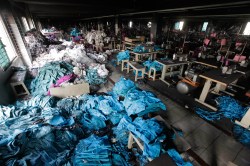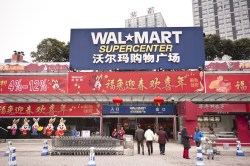Walmart has staked the lion’s share of its sustainability program on greening its supply chain. Instead of changing its own business practices — selling flimsy, landfill-bound products and building sprawling stores that can only be reached by car, for example — Walmart has said that it can make more headway on greenhouse gas emissions by pushing its suppliers around the world to reduce their energy and resource use.

Reuters / Andrew BirajThe Tazreen factory where workers made clothes for Walmart until a tragic fire on Nov. 24.
But in the aftermath of the horrific fire that took the lives of 112 workers at the Tazreen garment factory in Bangladesh, it has become clear that Walmart has no credibility with regard to its supply chain. Its actions in the months leading up to the fire, and its obfuscations in the weeks since, demonstrate that Walmart cannot be trusted to put principles above greed, even when it explicitly states that it will do so, nor even to tell the truth about which factories are producing its goods.
In the wake of the Nov. 24 fire, Walmart at first said that it could not confirm that it had ever sourced apparel from the Tazreen factory, even though a document on the website of the factory’s parent company showed that Walmart had audited the factory in May 2011 and had found “higher-risk violations.”
Two days later, when The Nation published photos of Walmart-branded clothing in the charred ruins of the factory, Walmart admitted that the factory produced goods for its shelves, but said that it had removed the facility from its approved factory list at some point prior to the fire. Walmart claimed that a rogue supplier had continued filling orders there in violation of the retailer’s ban.
If Walmart did indeed suspend the factory — it has not responded to journalists’ questions about exactly when and why it did so — then it appears the company failed to inform its suppliers of the decision. According to The New York Times, the Tazreen factory was running orders for at least two Walmart suppliers at the time of the fire and, as recently as mid-September, five Walmart suppliers were using the factory.
Over the last few years, even as Walmart has been touting its efforts to cut waste and improve energy efficiency at Chinese factories, it has also been rapidly shifting apparel production to Bangladesh. Since 2006, Bangladesh has grown from the sixth largest apparel exporter in the world to the second, after China. What’s driving this shift? Wages and production costs in China are rising, while Bangladesh remains dirt cheap. Its mostly female garment workers earn as little as $37 a month and, with the country’s lax environmental and safety standards, overhead costs are remarkably low.
Most Bangladeshi garment factories lack even rudimentary fire safety features. When workers on the upper floors of the Tazreen factory tried to flee, they found locked exits, blocked stairwells, and limited fire-fighting equipment. They are not the first to die trapped inside a blazing factory. More than 600 of the country’s garment workers have perished in fires since 2005, according to the International Labor Rights Forum.
This fire danger is well known to big retail chains. In Walmart’s 2012 Global Responsibility Report — the same report it uses to extol its sustainability initiatives — Walmart devotes more than a dozen pages to its Ethical Sourcing program and even talks up its work to reduce fire risks in Bangladeshi factories. “We visited our supplier factories to understand which ones met the [fire safety] criteria, and then worked with our suppliers in Bangladesh to phase their production out of buildings identified as high risk for fire safety hazards,” the report states. “Walmart proactively works with other brands and retailers to increase awareness and implementation of best practices for fire safety prevention in Bangladesh.”
Its “proactive” work with other retailers included a meeting held in Bangladesh in April 2011, at which Walmart and a dozen other retailers discussed a contractually enforceable memorandum that would require them to pay suppliers enough to cover the cost of safety improvements. According to the Associated Press, the discussions seemed promising until Sridevi Kalavakolanu, a director of ethical sourcing at Walmart, spoke. “In most cases very extensive and costly modifications would need to be undertaken to some factories,” Kalavakolanu is quoted as saying in the meeting minutes. “It is not financially feasible … to make such investments.” Her statement “sucked the air out of the room,” the AP reported, and “set the tone for the rest of the meeting, which ended the next day without a single company agreeing to the plan.”
(Kalavakolanu has given presentations about Walmart’s sustainability initiatives. She has also blogged on Walmart’s Green Room website about the company’s efforts to empower the women who work in Bangladeshi garment factories.)
The Worker Rights Consortium has estimated that it would cost up to $3 billion over the next five years to upgrade Bangladeshi factories. That would add about 3 percent to what Walmart and other companies now pay for apparel. Since production costs are only a small fraction of the final price of a T-shirt or a jacket, the cost to consumers would be pennies per garment.
If Walmart will not pay 3 percent more for basic fire safety, if it readily abandons factories when cheaper production can be had elsewhere, if it declines even to come clean about where its goods are made, then how can we buy Walmart’s claim that it is initiating an environmental revolution all along its supply chain, one that will transform factories across Asia into models of sustainability?

pcruciatti / Shutterstock.comEven as Walmart builds more stores in China, it’s shifting production to low-cost factories in Bangladesh.
There is no accountability. Walmart can give reporters tours of select Chinese factories with impressive energy-efficiency gains, while much of its production continues to happen in the shadows. It can enlist support from mainstream environmental groups and publish lengthy annual reports that offer heartwarming tales of reducing pollution and improving the lives of production workers, all the while rapidly expanding a fundamentally destructive business model.
One of the greatest advantages of a global supply chain for corporations like Walmart is that it opens a vast distance between consumers and producers, rendering the injustices involved in making a garment or a television set virtually invisible to the end buyer.
The only true path out is to close that distance — to ensure that those who consume the products are also those who feel the impact of how they are made. That means bringing much of our manufacturing back home, where we can collectively weigh the costs and benefits of going cheap on safety and pollution controls. It means building an economy rooted in local and regional relationships among consumers and businesses, where real accountability is possible. It also means a radical revamping of global trade rules to ensure that the goods we do import reflect our values and the profits from our consumption are not siphoned off by corporations but actually benefit those who make the stuff we buy.
In short, achieving Walmart’s stated goal of an “environmentally and socially responsible supply chain” entails phasing out Walmart itself and bringing an end to its inherently unaccountable and unsustainable system of production and distribution.



